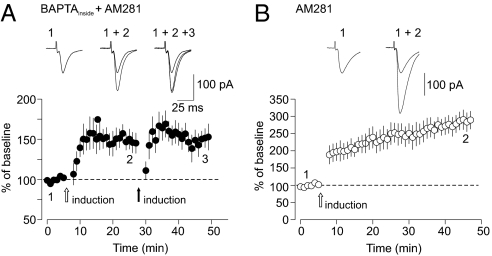Fig. 5.
Properties of LTP induced with post-LTP protocol in the presence of BAPTA in the pipette solution and AM281 in the external medium. (A) First, LTP was induced in thalamic input with the post-LTP protocol in the presence of AM281 (0.5 μM) in the bath and 20 mM BAPTA in the pipette solution. Subsequent delivery of the pre-LTP–inducing protocol (thalamic input was stimulated for 2 min with paired pulses at 2 Hz frequency at a holding potential of −70 mV) did not result in additional potentiation (n = 6, P = 0.56 vs. LTP with the post-LTP protocol). This was not caused by washout of pre-LTP, because it could be induced at ∼30 min after beginning the whole-cell recording (Fig. 4B). The observed occlusion of pre-LTP suggests that two forms of plasticity might be mechanistically similar. (Insets) Averaged EPSCs before (1) and after delivery of the first (2) and the second (3) LTP-inducing stimulation protocols. (B) Delivery of the post-LTP induction protocol in the presence of AM281 (0.5 μM) but without BAPTA in the pipette solution resulted in the very large LTP. The EPSC was potentiated to 289 ± 26% of its baseline amplitude (n = 6, P = 0.0002 vs. pre-LTP alone), suggesting that both pre-LTP and post-LTP might be induced simultaneously under conditions where the endogenous cannabionoids (eCB) cascade is blocked. (Insets) Averaged EPCS before (1) and after (2) the induction of LTP. Error bars indicate SEM.

